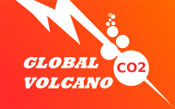GLOBAL VOLCANO CO2
Description

Global CO2 emission to the atmosphere from volcanes
Financed by
Plan Nacional I+D+I 2004-2007
Coordinated by
Pedro A. Hernández
Participants
División de Medio Ambiente ITER Laboratorio de Química de Terremotos Universidad de Tokio (Japón)
Abstract
Subaerial active volcanos emit a lot of gases to the atmosphere through its visible manifestations like plumes and fumaroles, but several research studies, done during the last 20 years, show that important emission levels of volcanic gases are possible through the soil too. This last kind of manifestations is also known as volcanic diffuse volcanic emanations and are characterized for it composition: mainly carbon dioxid (CO2),which is the second majority component of volcanic gases after water steam.
The ITERs Team of volcanology is going to carry out an ambitious research project that wants to evaluate the global diffuse emission rate of carbon dioxide (CO2) to the atmosphere due to subaerial volcanic activity. The aim of this project , financed by the 2004-2007 D+R National Plan of the Education and Science Ministry, is to improve our current knowledge of the carbone dioxide (CO2) quantity that is emited by subaerial volcanic activity. Nowadays, this parameter is underestimated.
To achieve this objective, the ITERs team of volcanology is going to carry out researches on carbone dioxide(CO2) diffuse emisions to the atmosphere during the next three years in a set of thirty actives volcanos, which are located in Papua New Guinea, El Salvador, Nicaragua, Costa Rica, Italy, Cape verde, Japan,Chile, Philippines,Reunión, Galápagos, Iceland and Azores. This future works will complete the researches already done by ITER during the last eight years in a set of twenty actives volcanos in Japan, El Salvador, Nicaragua, Costa Rica, Canary Islands, Papua New Guinea, Italy and Cape Verde, as well as the researches done by other scientific groups in different volcanos of Italy, Greece and USA.
The contribution of carbone dioxide (CO2) to the atmosphere due to volcanic activity is underestimated, because it is only refered to the degasification of lava and to the measures based on the emision of sulphur dioxide (SO2) jointed to the measure of carbone dioxide-sulphur dioxide rate (CO2/SO2) coming from visible volcanic emanations such as fumes and fumaroles.
Most of the researches on global carbone dioxide (CO2)emision due to subaerial volcanic activity done up to now have not consider difuse emanations of carbone dioxide (CO2). Therefore, the aim of this project is to carry out a wider study on CO2 difuse emanations to the atmopshere due to active volcanos located in different volcanologic environments and climatology, so that we can have in our´s disposal a better description of the global carbone dioxide (CO2) emision to the atmosphere due to subaerial volcanic activity.
The estimations of carbone dioxide emision done in around 20 volcanos represent a small percentage of the 165 subaerial volcanos that have erupted during the eigthies, and the 538 ones that have erupted for the last 500 years as well as the 1300 volcanos that have expirienced eruptive activity for the last 10.000 years.
In the case of vulcano (Italy), the total emision of carbone dioxide to the atmosphere estimated due to fumaroles activity and to difuse emision process is 3 times bigger than the ones estimated by measures in the fume. Recent studies in Masaya volcano in Nicaragua have estimated that difuse emision of carbone dioxide to the atmosphere was 9 times higher than the one estimated by measures in the fume. This examples show us that the difuse degasification process can be very important and should be taken into account.
However, difuse degasification studies in volcanos are still insufficient.
The number of direct observations that allow us assessing the contribution of carbone dioxide to the atmosphere due to subaerial volcanic avctivity is short, although there are facts and studies which prove that it is an important source of carbone dioxide emesion, approximately 250 anual millions of tones. The revision of this global contribution of carbone dioxide to the atmosphere, taking into account the carbone dioxide quantity of difuse volcanic emanations, can go so far as to be very meaningful and change the current estimated value. Therefore, to improve our current knowledge of the carbone dioxide (CO2) quantity that the subaerial volcanic activity emits in fact. It is important, although the impact of this quantity is nearly negligible compared to the emision sources of carbone dioxide to the atmopshere caused by the use of fosil fuels (26.000 millons tones/year). The global emision of CO2 to the atmopshere due to volcanos has been currently estimated to represent the 0,9% of the carbone dioxide emision related to fosil fuels.
On the other hand, the rol of terrestrial degasification through its main windows -volcanos, atmospheric carbone balance and global climate change - is very important if we consider the geological scale of time. In a shorter scale of time, carbone emision to the atmophere through the earth´s lithosphere is considered to be insignificant regarding to the contribution of biogenic and anthropogenic fluxes. Even though, it is necessary a careful check and quantifaction of the litosphere degasification process to have a better knowledge of the CO2 quantity that is being emited to the atmosphere at the present time.
Recently, some studies have proven the importance of carbone dioxide emisions to the atmosphere as consequence of tectonic, volcanic and hydrothermal processes, which contribute to the Greenhouse effect and the Global warming.